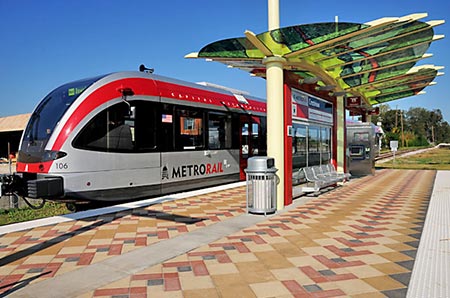Automobiles Commuting: electric car future
by Patrick
Comments Off on Suck in your knees, and meet the future
Suck in your knees, and meet the future
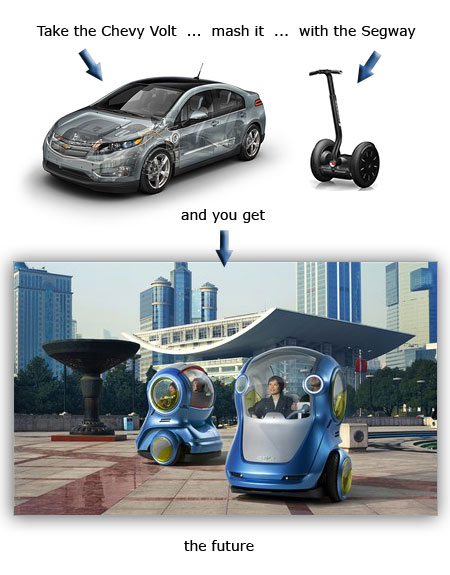
Imagine puttering around on a barstool, bumping elbows with the person next to you and hugging the bumper of the car in front.
You’re in an Electric Networked Vehicle, a smart electric car that will be able to drive, brake and pack more cars into shorter stretches of road while keeping traffic moving.
General Motors will display three models at the World Expo in May.
INRIX: Congestion in SA slightly worse
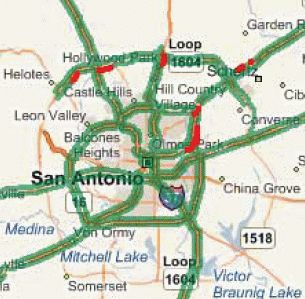
Top 10 SA-area bottlenecks (in red)
Traffic data services company INRIX’s annual “National Traffic Scorecard” was released a few weeks ago, and it shows that traffic congestion in San Antonio increased slightly over the past year.
This year, San Antonio ranked 25th in the nation in terms of overall traffic congestion. After flip-flopping with Houston last year, the Dallas-Ft. Worth area regained the title as Texas’ most congested region, landing at the number five spot nationally. Houston was sixth, and Austin was 23rd. The Los Angeles area was tops.
Commuting Passenger rail: Austin
by Patrick
Comments Off on Austin back in the passenger rail game
Austin back in the passenger rail game
After a 70-year hiatus, much debate and then a yearlong delay, Austin will soon join American cities that have added passenger rail back into the commuting mix.
On March 22, Capital Metro will start running diesel trains on a 32-mile route with nine stops from Leander to downtown Austin, the agency recently announced. A one-way trip will last a little more than an hour and the regular fare will be $3.
Trains will come by every 35 minutes during peak travel times, the Austin American-Statesman reported. Nearly 200 people can fit in a car, including standing room.
To match the capacity of a highway lane, you’d have to hook up three cars at a time and run them every 15 minutes.
Metro shelled out $105 million for its rail system, a figure that doesn’t include some direct costs, the Statesman said. Still, at about $3.3 million a mile, using an old rail line, the city struck a bargain as far as rail projects go.
Commuting Construction and closures History Roads Transit Uncategorized
by Hugh
1 comment
The only thing to look forward to is the past
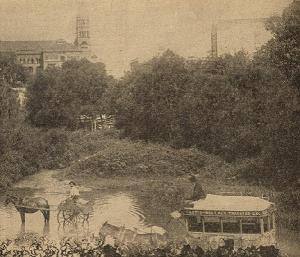
Omnibus soaking its wheels in the SA river
With all the zippidy-doo-dah hoopla over the possibility of a return to streetcars, why not go the whole hog and bring back mule drawn omnibuses? I mean, who else is doing that? Let’s think outside the box and get out of Portland, Oregon’s shadow once and for all. Think of the benefits. No expensive overhead or the need to tear up streets for miles on end and tourists will love it.
Mule drawn streetcars were introduced in San Antonio in 1878 but omnibus service has that beat by seven years. It cost 5 cents to go from Main Square to Alamo Plaza. With all the money we’ll save by not installing staggeringly expensive streetcar systems and their unsightly overhead power lines, we could go back and charge the same fare in 2010 that it was in 1871. I guess there is a flaw in my logic somewhere but, you know, I’ll be d****d if I know what it is.
Commuting Passenger rail Roads Toll roads Transit: Broadway South Alamo Street streetcars U.S. 281
by Patrick
Comments Off on Streetcar dreams: Now it’s time to talk money
Streetcar dreams: Now it’s time to talk money
After starting the fiscal year by shaving $19 million in spending, including 330 jobs, the city is now being asked to kick in $17 million to build a two-mile streetcar line.
That’s just part of the bill to buy streetcars and lay rails along Broadway and South Alamo Street by 2014. The county, VIA Metropolitan Transit and the federal government could also pony up to help pay what would be an estimated $90 million.
City Council heard the pitch this afternoon.
“If there was any sticker shock … council members mostly kept it to themselves,” the Express-News wrote.
The city hasn’t made any commitments, at least not yet.
At $45 million a mile, the price tag is quite a bit cheaper than, say, turning U.S. 281 out by Stone Oak into a superhighway, or, I should say, tollway.
Ah, but already I’m talking apples and oranges. This quaint two-mile rail line wouldn’t be a wide commuter route helping connect San Antonio’s core to its fringes.
Nope, unlike U.S. 281’s role as an artery for sprawl, the rail line, if done well, would be a magnet for compact living, working and playing. The idea is to drive some growth to the inner city, by creating a place where people would gladly leave their cars behind more often. Tourists would love it too.
Nonetheless, critics and proponents will duke it out with such comparisons. And with so many angles on varying public and private costs, some visible and some not so visible, expect a debate that’s about as clear as mud.
Docs and links:
Commuting Passenger rail: commuter rail light-rail
by Brian
Comments Off on The difference between commuter rail and light-rail
The difference between commuter rail and light-rail
Commuting Safety: flooding weather
by Patrick
Comments Off on Wet and woolly weekend
Wet and woolly weekend
With storms expected into the weekend, experts are sounding the warnings about the many dangers that can sneak up on motorists.
Tires can suddenly slip on a sheet of water. Rain splattering a windshield can blind you at a critical moment.
But the leading cause of weather-related deaths in Texas is flash flooding, according to state officials. Drivers often can’t tell how deep water is in low spots, and as little as six inches can sweep vehicles away, even pickups and SUVs.
The National Weather Service, forecasting heavy rain through Friday, has issued a flash flood warning in San Antonio and throughout South Texas.
The Texas Department of Transportation tonight released this flood advisory:
- Never walk, swim or drive through swift water.
- If you don’t heed No. 1, and your vehicle stalls in deep water, ditch the car and head to higher ground if you can do so safely.
And for those who can’t remember that, here goes: “Turn Around, Don’t Drown.”
Bicycles Commuting History Laws and policies Oil and gas prices Roads Safety Transit
by Hugh
4 comments
My first year as a born again cyclist in San Antonio
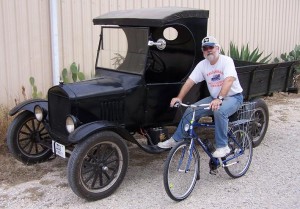 Around four o’clock in the afternoon of Thursday December 31st, zooming alongside the old San Antonio & Aransas Pass railroad tracks on Villamain between Mission San Juan and Mission Espada, in top gear and the wind at my back, I reached my own personal milestone by completing one thousand miles in the first year of owning a bicycle since I left Scotland in 1991. Today, Jnauary 9th, also around 4:00 PM, on De Zavala Road at Clark High school I reached by personal goal of 1,040 miles. That, of course, may seem like an obscure number, so let me explain. more »
Around four o’clock in the afternoon of Thursday December 31st, zooming alongside the old San Antonio & Aransas Pass railroad tracks on Villamain between Mission San Juan and Mission Espada, in top gear and the wind at my back, I reached my own personal milestone by completing one thousand miles in the first year of owning a bicycle since I left Scotland in 1991. Today, Jnauary 9th, also around 4:00 PM, on De Zavala Road at Clark High school I reached by personal goal of 1,040 miles. That, of course, may seem like an obscure number, so let me explain. more »
Commuting History Roads Safety Transit Travel Uncategorized
by Hugh
Comments Off on Book review: Traffic, by Tom Vanderbilt
Book review: Traffic, by Tom Vanderbilt
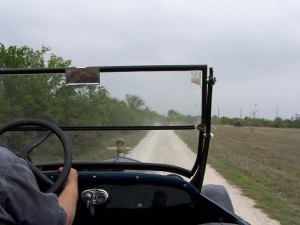 I’ve just finished reading “TRAFFIC,” by Tom Vanderbilt, published by Vintage Books in 2009. It is subtitled, “Why we drive the way we do and what it says about us.” I heartily recommend it to anyone interested in trying to understand the mundane yet highly complex activity we call driving.
I’ve just finished reading “TRAFFIC,” by Tom Vanderbilt, published by Vintage Books in 2009. It is subtitled, “Why we drive the way we do and what it says about us.” I heartily recommend it to anyone interested in trying to understand the mundane yet highly complex activity we call driving.
Commuting Oil and gas prices Safety Transit Travel
by Hugh
Comments Off on psi – check your tires
psi – check your tires
Here’s a new year’s resolution you might adopt: Check the air pressure on your vehicle’s tires at the beginning of each month. I was reminded of this when I checked mine at the beginning of this week. I began to notice my vehicle, a 2005 Dodge Caravan, was not handling as well as it should. Some of you may think it is oxymoronic to use handling characteristics in reference to a minivan but the thing just didn’t feel right. Sure enough, each tire was 4 psi – pounds per square inch – low. The ‘bus has new tires, maybe two months old, and I checked them in mid November, prior to a trip to Houston. I was surprised how much the tires went down following the recent cold snap. So, maybe you should make checking your tires a monthly chore. Just being one or two psi down can really affect miles per gallon plus, it just feels better.
